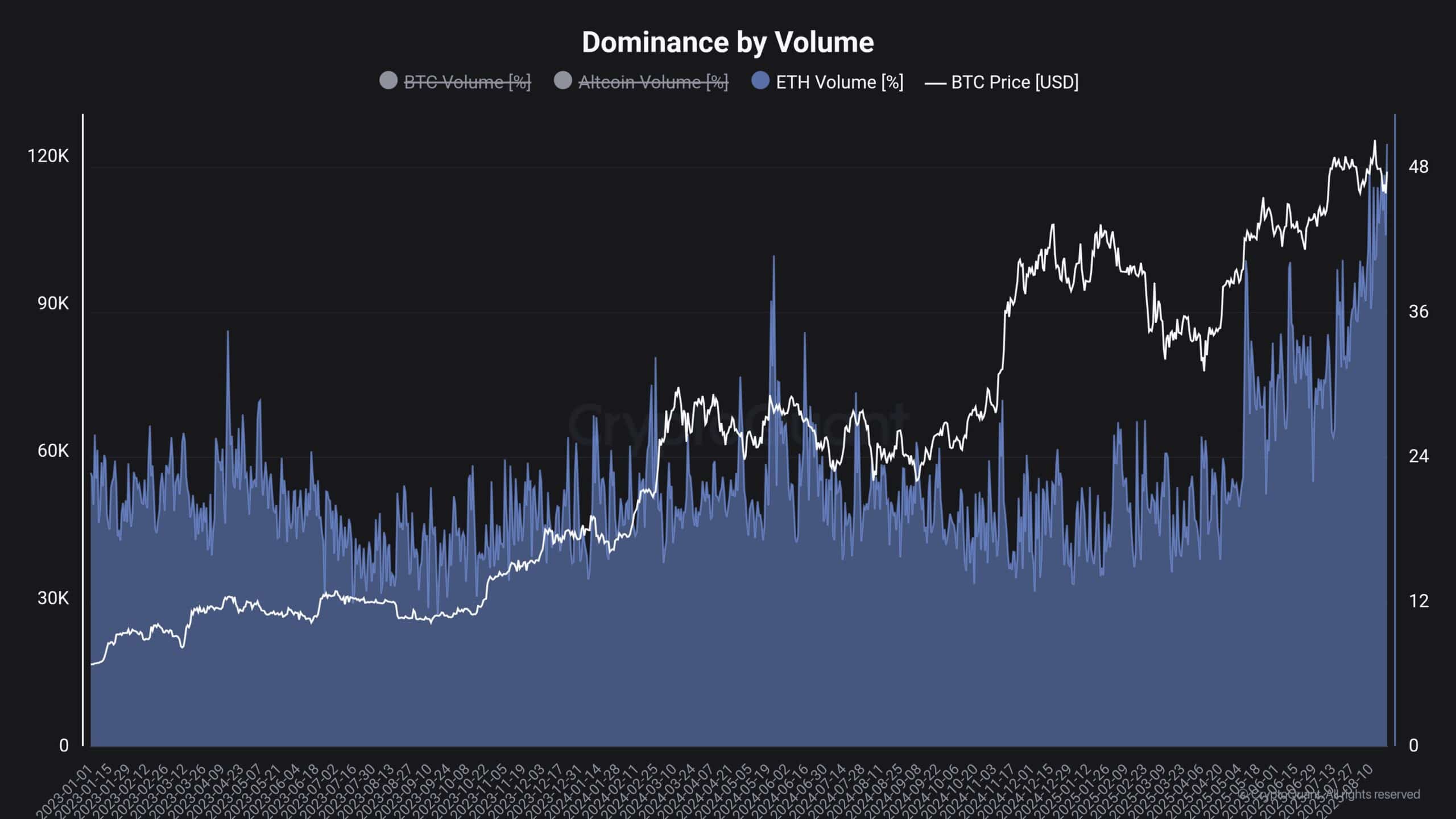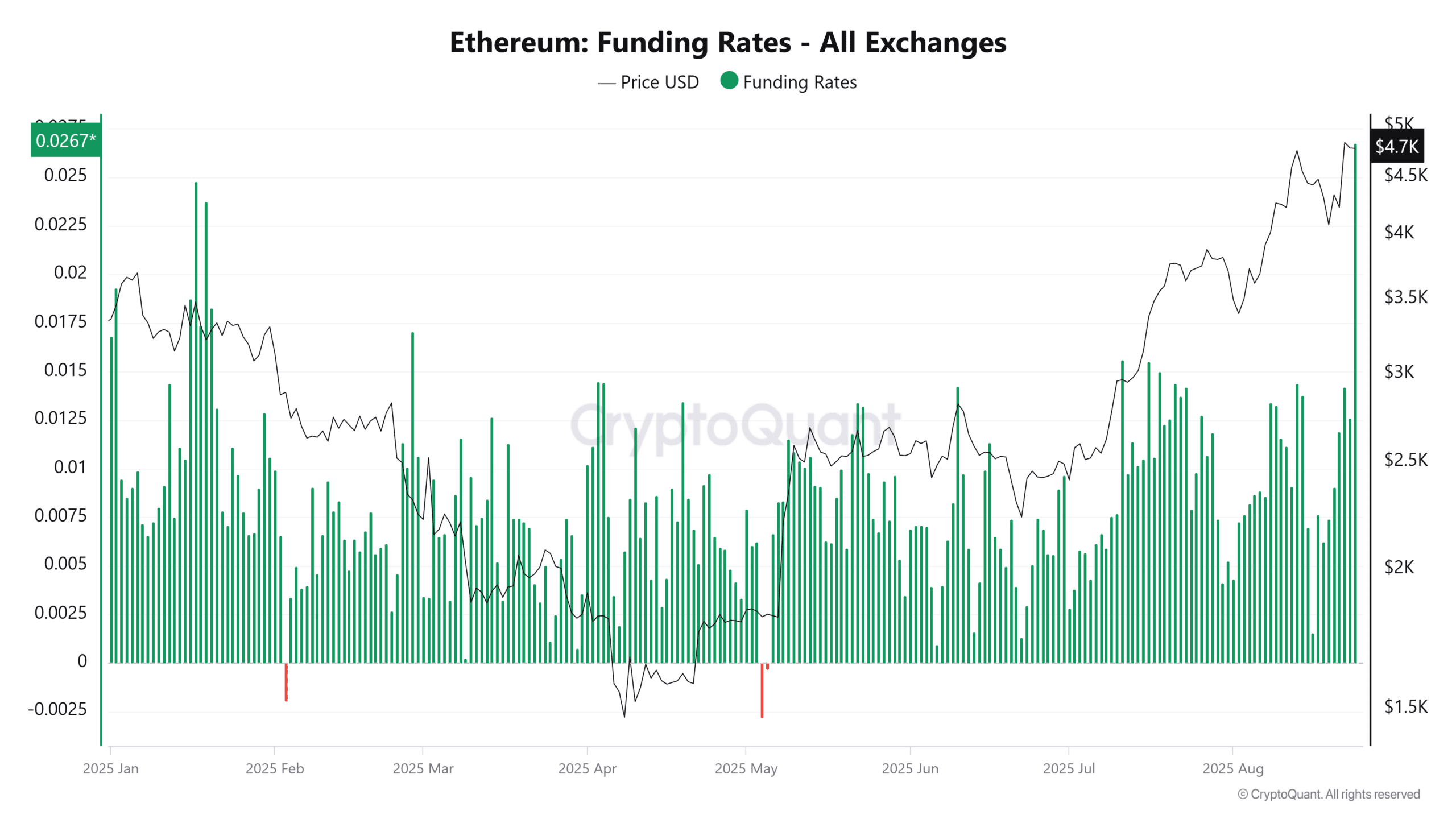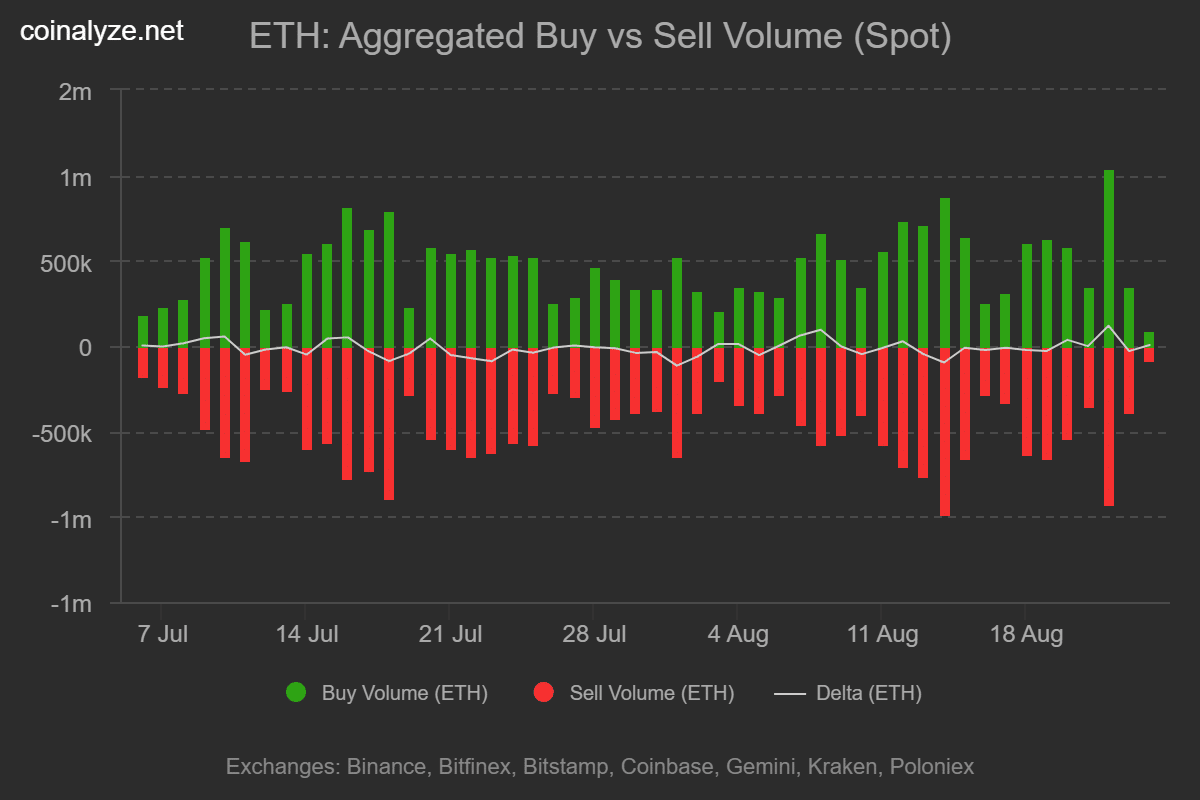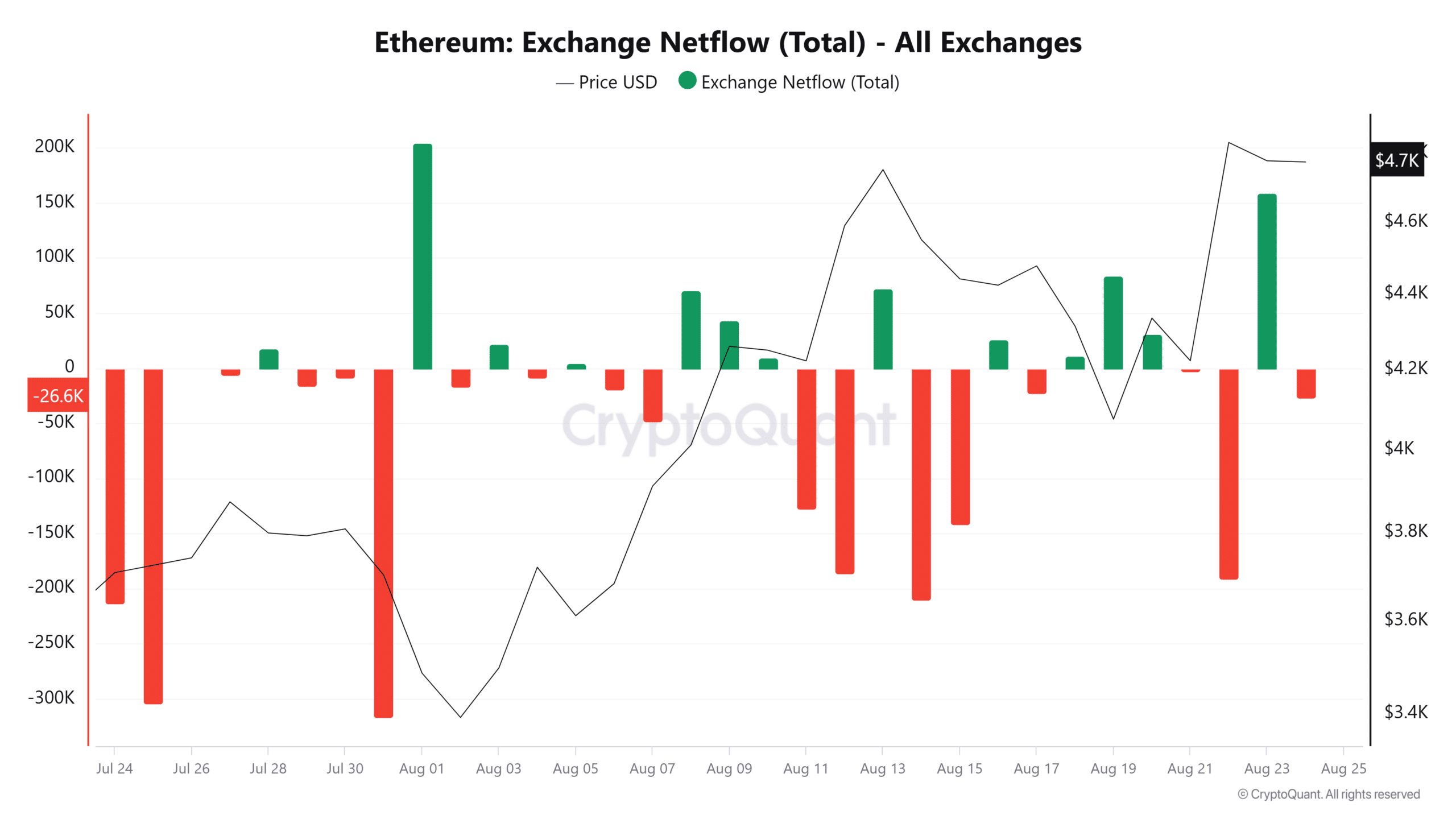| COINOTAG recommends • Exchange signup |
| 💹 Trade with pro tools |
| Fast execution, robust charts, clean risk controls. |
| 👉 Open account → |
| COINOTAG recommends • Exchange signup |
| 🚀 Smooth orders, clear control |
| Advanced order types and market depth in one view. |
| 👉 Create account → |
| COINOTAG recommends • Exchange signup |
| 📈 Clarity in volatile markets |
| Plan entries & exits, manage positions with discipline. |
| 👉 Sign up → |
| COINOTAG recommends • Exchange signup |
| ⚡ Speed, depth, reliability |
| Execute confidently when timing matters. |
| 👉 Open account → |
| COINOTAG recommends • Exchange signup |
| 🧭 A focused workflow for traders |
| Alerts, watchlists, and a repeatable process. |
| 👉 Get started → |
| COINOTAG recommends • Exchange signup |
| ✅ Data‑driven decisions |
| Focus on process—not noise. |
| 👉 Sign up → |
Ethereum futures dominance is rising as ETH futures volume surged to $162.6 billion, capturing roughly half of total futures trading. Strong open interest, higher funding rates and net outflows from exchanges show coordinated spot and derivatives demand driving ETH’s short-term upside.
-
ETH futures volume: $162.6B — ~50% of total futures market
-
Open interest jumped from $59B to $70B, signaling sustained capital inflows.
-
Funding rates hit a 7‑month high (0.026), indicating bullish long pressure.
Meta description: Ethereum futures dominance climbs as ETH futures volume hits $162.6B and open interest rises; learn implications for price and market flow. Read analysis now.
What is Ethereum futures dominance and why does it matter?
Ethereum futures dominance describes ETH’s share of total crypto futures activity. When ETH futures volume and open interest increase relative to Bitcoin, it signals capital rotation and stronger speculative and hedging demand for ETH — a key indicator for near-term price momentum and market sentiment.
| COINOTAG recommends • Professional traders group |
| 💎 Join a professional trading community |
| Work with senior traders, research‑backed setups, and risk‑first frameworks. |
| 👉 Join the group → |
| COINOTAG recommends • Professional traders group |
| 📊 Transparent performance, real process |
| Spot strategies with documented months of triple‑digit runs during strong trends; futures plans use defined R:R and sizing. |
| 👉 Get access → |
| COINOTAG recommends • Professional traders group |
| 🧭 Research → Plan → Execute |
| Daily levels, watchlists, and post‑trade reviews to build consistency. |
| 👉 Join now → |
| COINOTAG recommends • Professional traders group |
| 🛡️ Risk comes first |
| Sizing methods, invalidation rules, and R‑multiples baked into every plan. |
| 👉 Start today → |
| COINOTAG recommends • Professional traders group |
| 🧠 Learn the “why” behind each trade |
| Live breakdowns, playbooks, and framework‑first education. |
| 👉 Join the group → |
| COINOTAG recommends • Professional traders group |
| 🚀 Insider • APEX • INNER CIRCLE |
| Choose the depth you need—tools, coaching, and member rooms. |
| 👉 Explore tiers → |
How large was the recent ETH futures volume spike?
CryptoQuant data shows ETH futures volume reached $162.6 billion, roughly 50% of the total futures market. That volume surge coincided with open interest rising from about $59 billion to $70 billion, confirming both increased trading activity and persistent positions across exchanges.
Source mentions (plain text): CryptoQuant, CoinGlass, Coinalyze, Lookonchain, COINOTAG
| COINOTAG recommends • Exchange signup |
| 📈 Clear interface, precise orders |
| Sharp entries & exits with actionable alerts. |
| 👉 Create free account → |
| COINOTAG recommends • Exchange signup |
| 🧠 Smarter tools. Better decisions. |
| Depth analytics and risk features in one view. |
| 👉 Sign up → |
| COINOTAG recommends • Exchange signup |
| 🎯 Take control of entries & exits |
| Set alerts, define stops, execute consistently. |
| 👉 Open account → |
| COINOTAG recommends • Exchange signup |
| 🛠️ From idea to execution |
| Turn setups into plans with practical order types. |
| 👉 Join now → |
| COINOTAG recommends • Exchange signup |
| 📋 Trade your plan |
| Watchlists and routing that support focus. |
| 👉 Get started → |
| COINOTAG recommends • Exchange signup |
| 📊 Precision without the noise |
| Data‑first workflows for active traders. |
| 👉 Sign up → |
How do funding rates and open interest affect ETH price action?
Funding rates reflect the cost of holding perpetual futures; a positive funding rate (currently ~0.026) implies longs pay shorts and suggests bullish sentiment. Rising open interest alongside positive funding typically indicates new money entering long positions rather than short covering.
When funding and open interest climb together, the probability of a leveraged-driven rally increases, but so does the risk of sharp liquidations if sentiment reverses.
| COINOTAG recommends • Traders club |
| ⚡ Futures with discipline |
| Defined R:R, pre‑set invalidation, execution checklists. |
| 👉 Join the club → |
| COINOTAG recommends • Traders club |
| 🎯 Spot strategies that compound |
| Momentum & accumulation frameworks managed with clear risk. |
| 👉 Get access → |
| COINOTAG recommends • Traders club |
| 🏛️ APEX tier for serious traders |
| Deep dives, analyst Q&A, and accountability sprints. |
| 👉 Explore APEX → |
| COINOTAG recommends • Traders club |
| 📈 Real‑time market structure |
| Key levels, liquidity zones, and actionable context. |
| 👉 Join now → |
| COINOTAG recommends • Traders club |
| 🔔 Smart alerts, not noise |
| Context‑rich notifications tied to plans and risk—never hype. |
| 👉 Get access → |
| COINOTAG recommends • Traders club |
| 🤝 Peer review & coaching |
| Hands‑on feedback that sharpens execution and risk control. |
| 👉 Join the club → |

CryptoQuant reported the volume spike, which coincided with major traders reallocating capital from BTC to ETH.
Why is spot demand important alongside futures dominance?
Spot demand validates derivatives flows. Coinalyze data recorded $90.8k in ETH buy volume versus $85k in sell volume (Buy-Sell Delta +5.6k), while exchange netflow registered -26.6k ETH — indicating withdrawals that reduce available exchange supply and support price.

| COINOTAG recommends • Exchange signup |
| 📈 Clear control for futures |
| Sizing, stops, and scenario planning tools. |
| 👉 Open futures account → |
| COINOTAG recommends • Exchange signup |
| 🧩 Structure your futures trades |
| Define entries & exits with advanced orders. |
| 👉 Sign up → |
| COINOTAG recommends • Exchange signup |
| 🛡️ Control volatility |
| Automate alerts and manage positions with discipline. |
| 👉 Get started → |
| COINOTAG recommends • Exchange signup |
| ⚙️ Execution you can rely on |
| Fast routing and meaningful depth insights. |
| 👉 Create account → |
| COINOTAG recommends • Exchange signup |
| 📒 Plan. Execute. Review. |
| Frameworks for consistent decision‑making. |
| 👉 Join now → |
| COINOTAG recommends • Exchange signup |
| 🧩 Choose clarity over complexity |
| Actionable, pro‑grade tools—no fluff. |
| 👉 Open account → |
CoinGlass and exchange netflow metrics support the view that both spot accumulation and futures positioning are aligning bullishly for ETH.

| COINOTAG recommends • Members‑only research |
| 📌 Curated setups, clearly explained |
| Entry, invalidation, targets, and R:R defined before execution. |
| 👉 Get access → |
| COINOTAG recommends • Members‑only research |
| 🧠 Data‑led decision making |
| Technical + flow + context synthesized into actionable plans. |
| 👉 Join now → |
| COINOTAG recommends • Members‑only research |
| 🧱 Consistency over hype |
| Repeatable rules, realistic expectations, and a calmer mindset. |
| 👉 Get access → |
| COINOTAG recommends • Members‑only research |
| 🕒 Patience is an edge |
| Wait for confirmation and manage risk with checklists. |
| 👉 Join now → |
| COINOTAG recommends • Members‑only research |
| 💼 Professional mentorship |
| Guidance from seasoned traders and structured feedback loops. |
| 👉 Get access → |
| COINOTAG recommends • Members‑only research |
| 🧮 Track • Review • Improve |
| Documented PnL tracking and post‑mortems to accelerate learning. |
| 👉 Join now → |
What are the bullish and bearish scenarios for ETH from here?
Bullish: Continued futures inflows, positive funding rates and negative exchange netflow could push ETH above $5,000, driven by both leverage and spot accumulation.
Bearish: If funding turns negative or open interest falls sharply, leveraged longs could be forced out and ETH could retest support near $4,205.
| COINOTAG recommends • Exchange signup |
| 🎯 Focus on process over noise |
| Plan trades, size positions, execute consistently. |
| 👉 Sign up → |
| COINOTAG recommends • Exchange signup |
| 🛠️ Simplify execution |
| Keep decisions clear with practical controls. |
| 👉 Get started → |
| COINOTAG recommends • Exchange signup |
| 📊 Make data your edge |
| Use depth and alerts to avoid guesswork. |
| 👉 Open account → |
| COINOTAG recommends • Exchange signup |
| 🧭 Be prepared, not reactive |
| Turn setups into rules before you trade. |
| 👉 Create account → |
| COINOTAG recommends • Exchange signup |
| ✍️ Plan first, then act |
| Entries, exits, and reviews that fit your routine. |
| 👉 Join now → |
| COINOTAG recommends • Exchange signup |
| 🧩 Consistency beats intensity |
| Small, repeatable steps win the long run. |
| 👉 Sign up → |
How should traders interpret these signals?
Traders should monitor three data points in tandem:
- Futures volume and ETH share of total futures (indicator of rotation).
- Open interest trends (new positions vs. liquidations).
- Exchange netflow and spot buy-sell delta (supply-side pressure).
How to read ETH futures dominance — step-by-step
Follow these steps to interpret the market:
| COINOTAG recommends • Premium trading community |
| 🏛️ WAGMI CAPITAL — Premium Trading Community |
| Strategic insights, exclusive opportunities, professional support. |
| 👉 Join WAGMI CAPITAL → |
| COINOTAG recommends • Premium trading community |
| 💬 Inner Circle access |
| See members share real‑time PnL and execution notes in chat. |
| 👉 Apply for Inner Circle → |
| COINOTAG recommends • Premium trading community |
| 🧩 Turn theses into trades |
| Reusable templates for entries, risk, and review—end to end. |
| 👉 Join the club → |
| COINOTAG recommends • Premium trading community |
| 💡 Long‑term mindset |
| Patience and discipline over noise; a process that compounds. |
| 👉 Get started → |
| COINOTAG recommends • Premium trading community |
| 📚 Education + execution |
| Courses, playbooks, and live market walkthroughs—learn by doing. |
| 👉 Get access → |
| COINOTAG recommends • Premium trading community |
| 🔒 Members‑only research drops |
| Curated analyses and private briefings—quality over quantity. |
| 👉 Join WAGMI CAPITAL → |
- Compare ETH futures volume to total futures to assess dominance.
- Check open interest: rising OI with rising price suggests fresh money; falling OI with rising price suggests short covering.
- Observe funding rates: persistent positive funding signals long-dominated leverage.
- Track exchange netflow and spot buy-sell delta for underlying supply/demand shifts.

Exchange netflow charts and buy-sell delta are essential cross-checks before acting on derivatives data.
| COINOTAG recommends • Exchange signup |
| 🧱 Execute with discipline |
| Watchlists, alerts, and flexible order control. |
| 👉 Sign up → |
| COINOTAG recommends • Exchange signup |
| 🧩 Keep your strategy simple |
| Clear rules and repeatable steps. |
| 👉 Open account → |
| COINOTAG recommends • Exchange signup |
| 🧠 Stay objective |
| Let data—not emotion—drive actions. |
| 👉 Get started → |
| COINOTAG recommends • Exchange signup |
| ⏱️ Trade when it makes sense |
| Your plan sets the timing—not the feed. |
| 👉 Join now → |
| COINOTAG recommends • Exchange signup |
| 🌿 A calm plan for busy markets |
| Set size and stops first, then execute. |
| 👉 Create account → |
| COINOTAG recommends • Exchange signup |
| 🧱 Your framework. Your rules. |
| Design entries/exits that fit your routine. |
| 👉 Sign up → |
Frequently Asked Questions
Does higher ETH futures volume mean ETH will outpace BTC?
Not necessarily. Higher futures volume indicates attention and capital flow but price leadership depends on sustained spot demand, macro factors and liquidity. Monitor open interest, funding and netflow for confirmation.
What does a positive funding rate mean for traders?
A positive funding rate means perpetual longs pay shorts, showing long-side dominance. Traders should be cautious: sustained high funding increases rollover costs and liquidation risk if the market reverses.
How reliable are exchange netflow signals?
Exchange netflow is a strong supply indicator: negative netflow (outflows) often supports price as exchange supply tightens. Use alongside spot volume and on-chain wallet activity for validation.
Key Takeaways
- ETH futures volume surge: $162.6B, ~50% of futures market — indicates major rotation into ETH.
- Derivatives and spot alignment: Rising open interest and positive funding plus negative exchange netflow point to coordinated demand.
- Trade plan: Watch OI, funding and netflow; sustained readings favor upside to $5k, failure could target $4,205.
Conclusion
Ethereum futures dominance and elevated ETH futures volume show a meaningful shift in market attention toward ETH. With open interest, funding rates and exchange netflow all skewing bullish, the market is positioned for further upside if these flows persist. Traders should monitor these metrics closely and adjust risk management as leveraged positioning grows.

Publication date: 2025-08-26 | Updated: 2025-08-26
| COINOTAG recommends • Members‑only research |
| 📌 Curated setups, clearly explained |
| Entry, invalidation, targets, and R:R defined before execution. |
| 👉 Get access → |
| COINOTAG recommends • Members‑only research |
| 🧠 Data‑led decision making |
| Technical + flow + context synthesized into actionable plans. |
| 👉 Join now → |
| COINOTAG recommends • Members‑only research |
| 🧱 Consistency over hype |
| Repeatable rules, realistic expectations, and a calmer mindset. |
| 👉 Get access → |
| COINOTAG recommends • Members‑only research |
| 🕒 Patience is an edge |
| Wait for confirmation and manage risk with checklists. |
| 👉 Join now → |
| COINOTAG recommends • Members‑only research |
| 💼 Professional mentorship |
| Guidance from seasoned traders and structured feedback loops. |
| 👉 Get access → |
| COINOTAG recommends • Members‑only research |
| 🧮 Track • Review • Improve |
| Documented PnL tracking and post‑mortems to accelerate learning. |
| 👉 Join now → |












